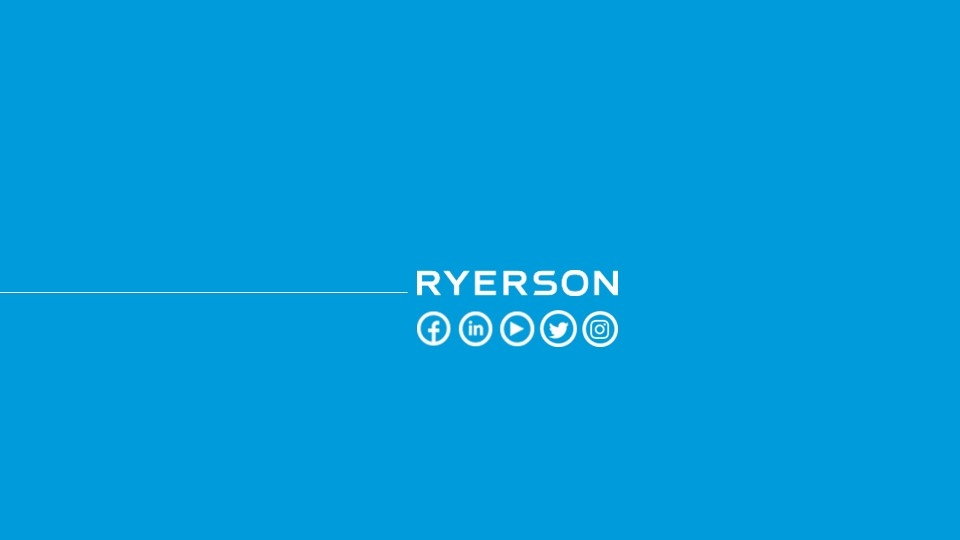Attached files
| file | filename |
|---|---|
| 8-K - 8-K - Ryerson Holding Corp | ryi-8k_20200608.htm |

Global Industrials & Materials Summit June 2020 Exhibit 99.1
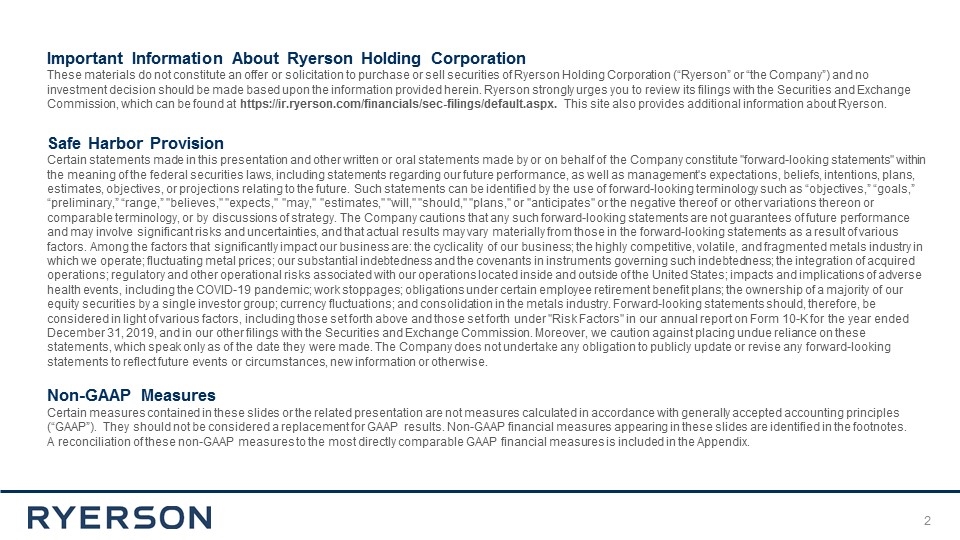
31 Important Information About Ryerson Holding Corporation These materials do not constitute an offer or solicitation to purchase or sell securities of Ryerson Holding Corporation (“Ryerson” or “the Company”) and no investment decision should be made based upon the information provided herein. Ryerson strongly urges you to review its filings with the Securities and Exchange Commission, which can be found at https://ir.ryerson.com/financials/sec-filings/default.aspx. This site also provides additional information about Ryerson. Safe Harbor Provision Certain statements made in this presentation and other written or oral statements made by or on behalf of the Company constitute "forward-looking statements" within the meaning of the federal securities laws, including statements regarding our future performance, as well as management's expectations, beliefs, intentions, plans, estimates, objectives, or projections relating to the future. Such statements can be identified by the use of forward-looking terminology such as “objectives,” “goals,” “preliminary,” “range,” "believes," "expects," "may," "estimates," "will," "should," "plans," or "anticipates" or the negative thereof or other variations thereon or comparable terminology, or by discussions of strategy. The Company cautions that any such forward-looking statements are not guarantees of future performance and may involve significant risks and uncertainties, and that actual results may vary materially from those in the forward-looking statements as a result of various factors. Among the factors that significantly impact our business are: the cyclicality of our business; the highly competitive, volatile, and fragmented metals industry in which we operate; fluctuating metal prices; our substantial indebtedness and the covenants in instruments governing such indebtedness; the integration of acquired operations; regulatory and other operational risks associated with our operations located inside and outside of the United States; impacts and implications of adverse health events, including the COVID-19 pandemic; work stoppages; obligations under certain employee retirement benefit plans; the ownership of a majority of our equity securities by a single investor group; currency fluctuations; and consolidation in the metals industry. Forward-looking statements should, therefore, be considered in light of various factors, including those set forth above and those set forth under "Risk Factors" in our annual report on Form 10-K for the year ended December 31, 2019, and in our other filings with the Securities and Exchange Commission. Moreover, we caution against placing undue reliance on these statements, which speak only as of the date they were made. The Company does not undertake any obligation to publicly update or revise any forward-looking statements to reflect future events or circumstances, new information or otherwise. Non-GAAP Measures Certain measures contained in these slides or the related presentation are not measures calculated in accordance with generally accepted accounting principles (“GAAP”). They should not be considered a replacement for GAAP results. Non-GAAP financial measures appearing in these slides are identified in the footnotes. A reconciliation of these non-GAAP measures to the most directly comparable GAAP financial measures is included in the Appendix.
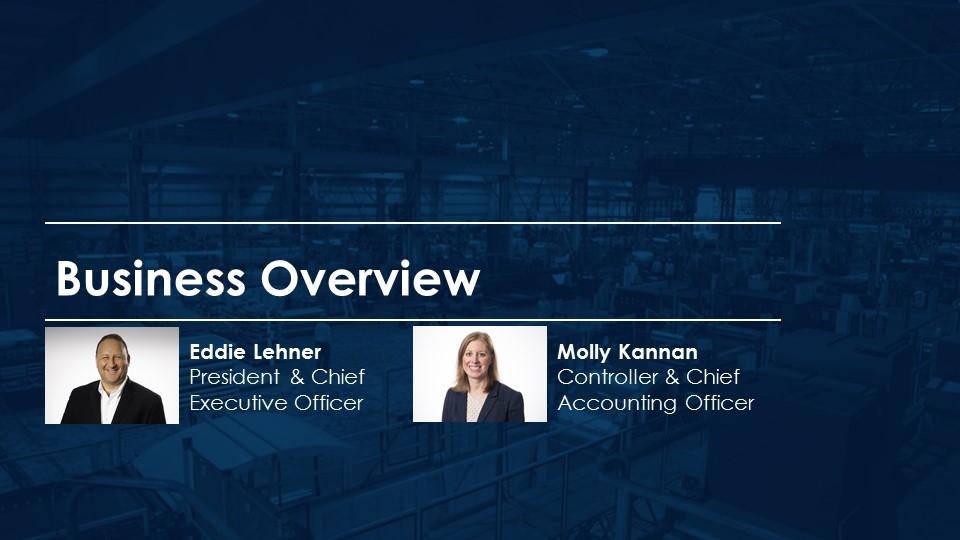
Business Overview Eddie Lehner President & Chief Executive Officer Molly Kannan Controller & Chief Accounting Officer
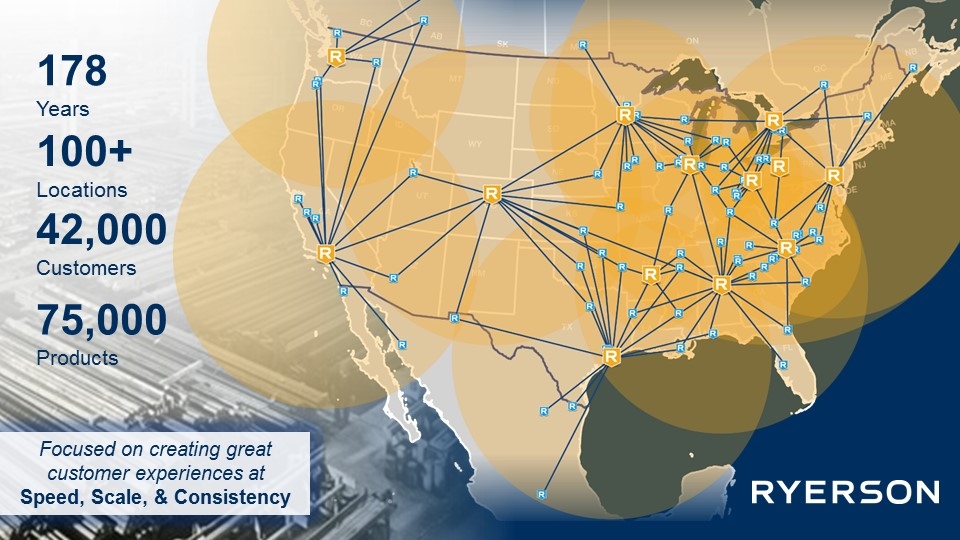
100+ Locations 178 Years 42,000Customers 75,000 Products Focused on creating great customer experiences at Speed, Scale, & Consistency
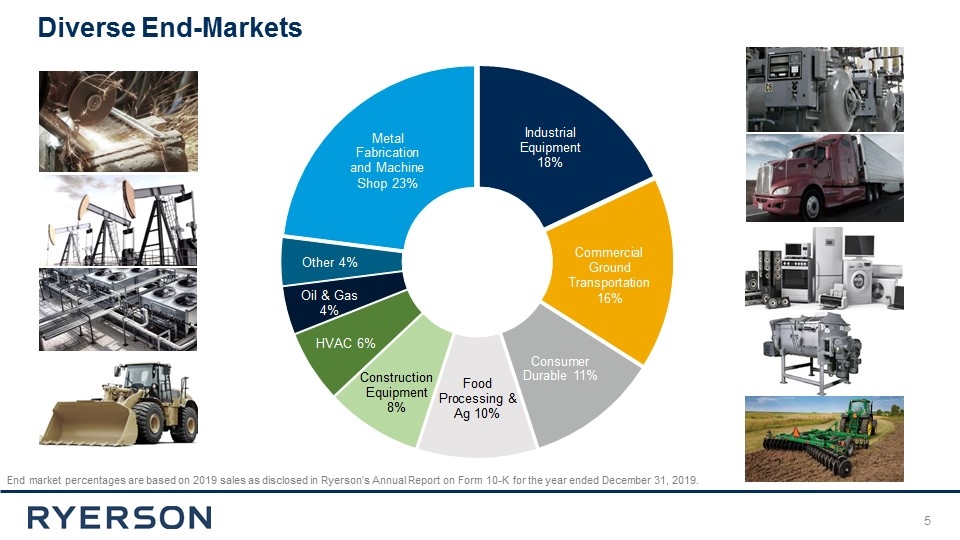
Diverse End-Markets End market percentages are based on 2019 sales as disclosed in Ryerson’s Annual Report on Form 10-K for the year ended December 31, 2019.
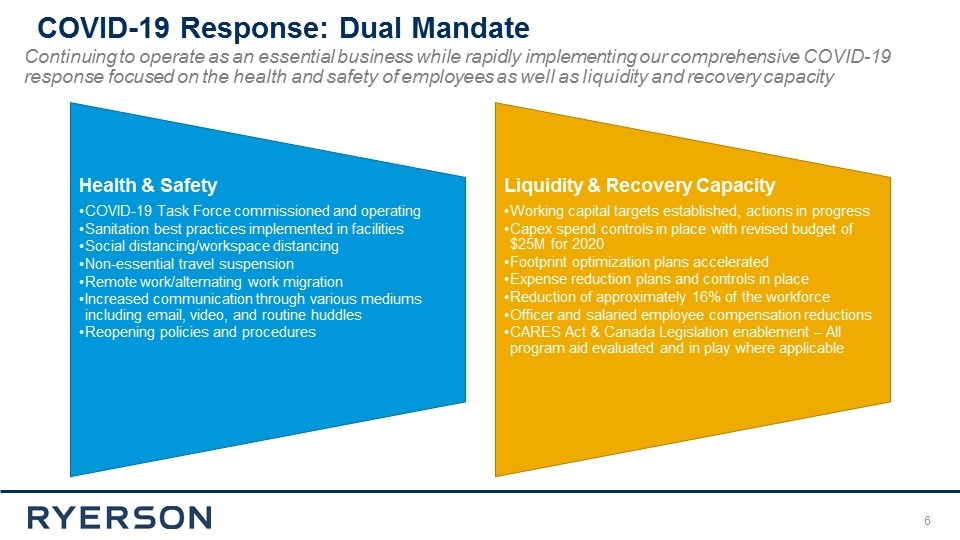
COVID-19 Response: Dual Mandate Continuing to operate as an essential business while rapidly implementing our comprehensive COVID-19 response focused on the health and safety of employees as well as liquidity and recovery capacity Health & Safety Sanitation best practices implemented in facilities Liquidity & Recovery Capacity Social distancing/workspace distancing Non-essential travel suspension Remote work/alternating work migration Increased communication through various mediums including email, video, and routine huddles Capex spend controls in place with revised budget of $25M for 2020 Expense reduction plans and controls in place Reduction of approximately 16% of the workforce CARES Act & Canada Legislation enablement – All program aid evaluated and in play where applicable Working capital targets established, actions in progress COVID-19 Task Force commissioned and operating Officer and salaried employee compensation reductions Reopening policies and procedures Footprint optimization plans accelerated
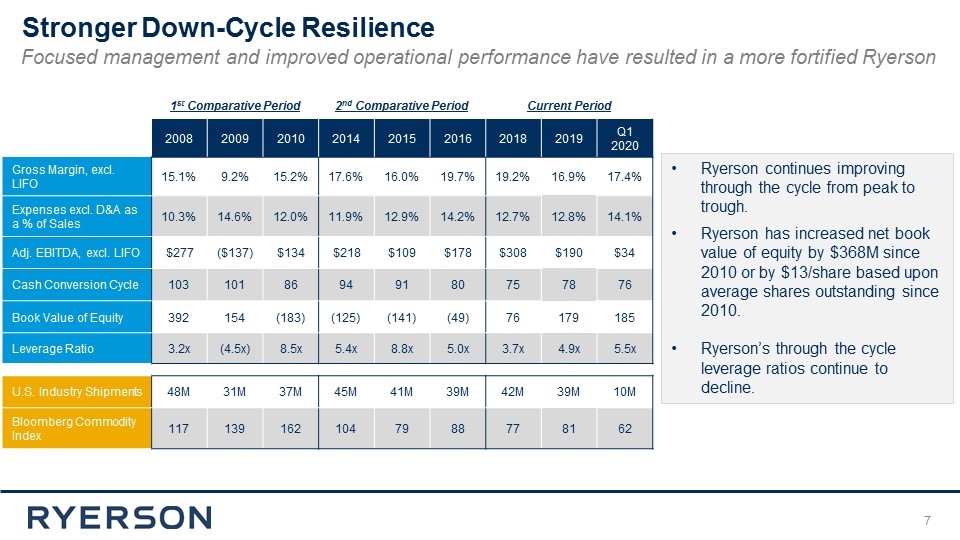
Focused management and improved operational performance have resulted in a more fortified Ryerson Stronger Down-Cycle Resilience 1st Comparative Period 2nd Comparative Period Current Period 2008 2009 2010 2014 2015 2016 2018 2019 Q1 2020 Gross Margin, excl. LIFO 15.1% 9.2% 15.2% 17.6% 16.0% 19.7% 19.2% 16.9% 17.4% Expenses excl. D&A as a % of Sales 10.3% 14.6% 12.0% 11.9% 12.9% 14.2% 12.7% 12.8% 14.1% Adj. EBITDA, excl. LIFO $277 ($137) $134 $218 $109 $178 $308 $190 $34 Cash Conversion Cycle 103 101 86 94 91 80 75 78 76 Book Value of Equity 392 154 (183) (125) (141) (49) 76 179 185 Leverage Ratio 3.2x (4.5x) 8.5x 5.4x 8.8x 5.0x 3.7x 4.9x 5.5x U.S. Industry Shipments 48M 31M 37M 45M 41M 39M 42M 39M 10M Bloomberg Commodity Index 117 139 162 104 79 88 77 81 62 Ryerson continues improving through the cycle from peak to trough. Ryerson has increased net book value of equity by $368M since 2010 or by $13/share based upon average shares outstanding since 2010. Ryerson’s through the cycle leverage ratios continue to decline.
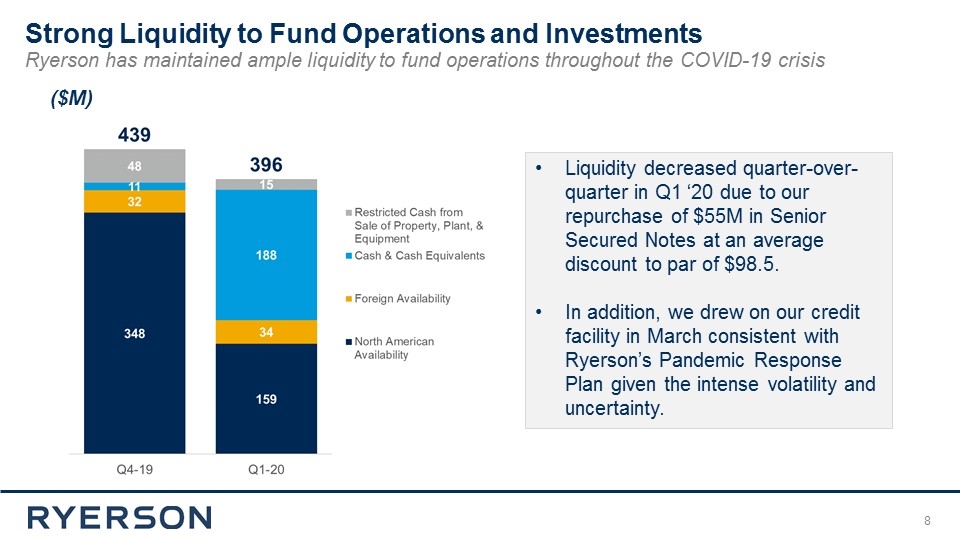
Strong Liquidity to Fund Operations and Investments Ryerson has maintained ample liquidity to fund operations throughout the COVID-19 crisis ($M) Liquidity decreased quarter-over-quarter in Q1 ‘20 due to our repurchase of $55M in Senior Secured Notes at an average discount to par of $98.5. In addition, we drew on our credit facility in March consistent with Ryerson’s Pandemic Response Plan given the intense volatility and uncertainty.
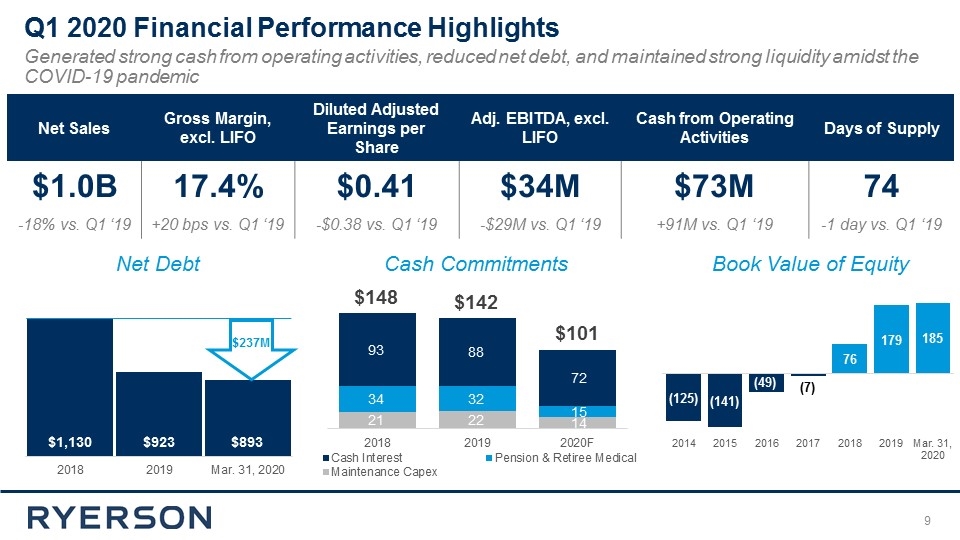
Q1 2020 Financial Performance Highlights Generated strong cash from operating activities, reduced net debt, and maintained strong liquidity amidst the COVID-19 pandemic Net Sales Gross Margin, excl. LIFO Diluted Adjusted Earnings per Share Adj. EBITDA, excl. LIFO Cash from Operating Activities Days of Supply $1.0B 17.4% $0.41 $34M $73M 74 -18% vs. Q1 ‘19 +20 bps vs. Q1 ‘19 -$0.38 vs. Q1 ‘19 -$29M vs. Q1 ‘19 +91M vs. Q1 ‘19 -1 day vs. Q1 ‘19 Net Debt $237M Cash Commitments Book Value of Equity
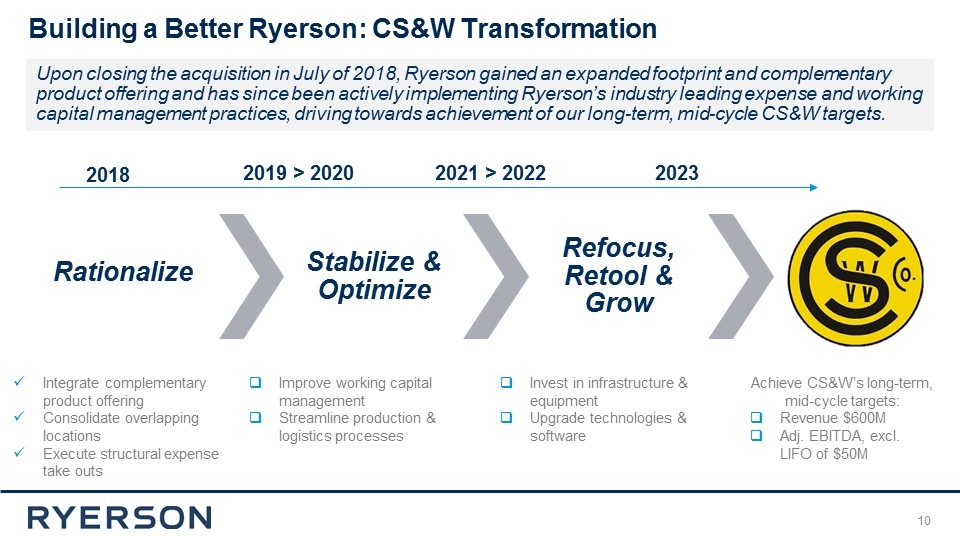
2019 > 2020 2021 > 2022 2023 2018 Building a Better Ryerson: CS&W Transformation Achieve CS&W’s long-term, mid-cycle targets: Revenue $600M Adj. EBITDA, excl. LIFO of $50M Integrate complementary product offering Consolidate overlapping locations Execute structural expense take outs Improve working capital management Streamline production & logistics processes Invest in infrastructure & equipment Upgrade technologies & software Upon closing the acquisition in July of 2018, Ryerson gained an expanded footprint and complementary product offering and has since been actively implementing Ryerson’s industry leading expense and working capital management practices, driving towards achievement of our long-term, mid-cycle CS&W targets. Rationalize Stabilize & Optimize Refocus, Retool & Grow
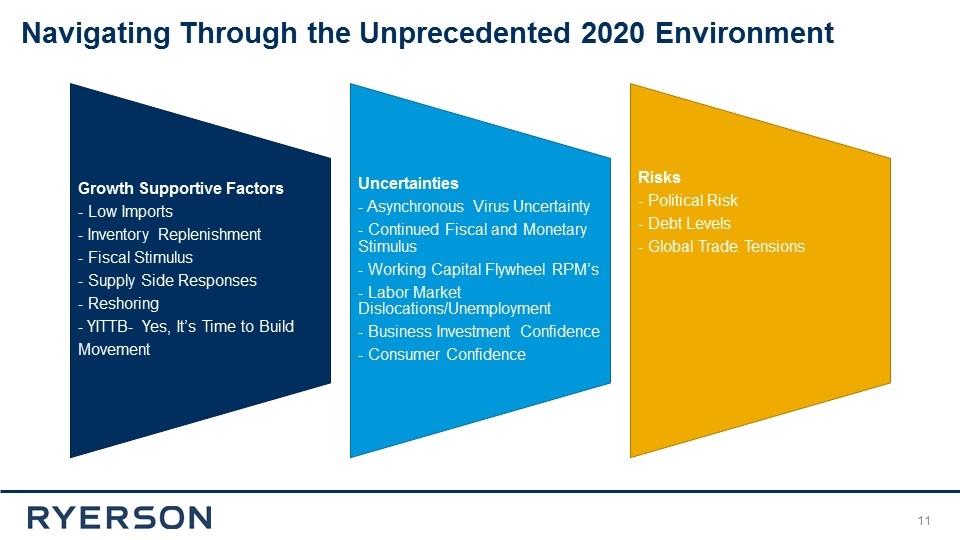
Navigating Through the Unprecedented 2020 Environment Growth Supportive Factors - Low Imports - Inventory Replenishment - Fiscal Stimulus - Supply Side Responses - Reshoring - YITTB- Yes, It’s Time to Build Movement Uncertainties - Asynchronous Virus Uncertainty - Continued Fiscal and Monetary Stimulus - Working Capital Flywheel RPM’s - Labor Market Dislocations/Unemployment - Business Investment Confidence - Consumer Confidence Risks - Political Risk - Debt Levels - Global Trade Tensions
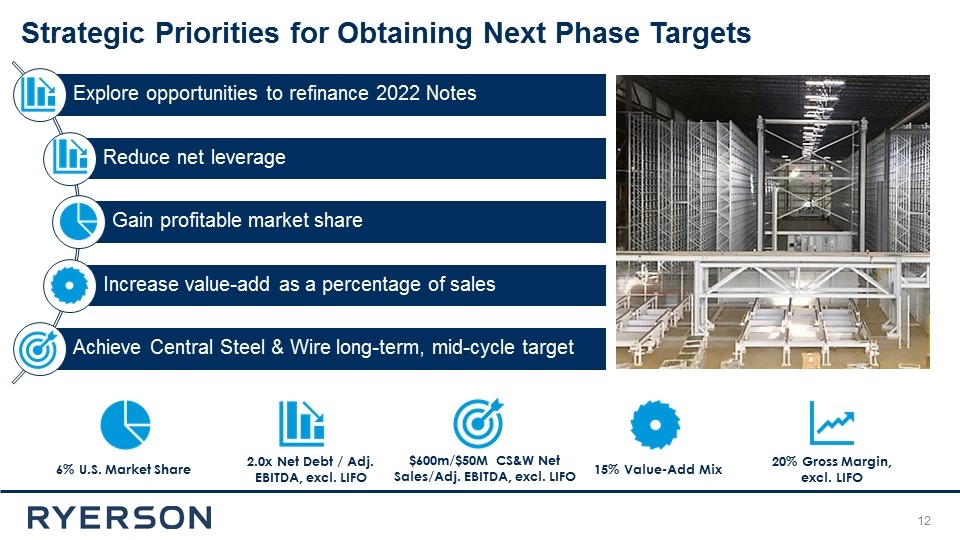
Strategic Priorities for Obtaining Next Phase Targets 6% U.S. Market Share 15% Value-Add Mix 20% Gross Margin, excl. LIFO 2.0x Net Debt / Adj. EBITDA, excl. LIFO $600m/$50M CS&W Net Sales/Adj. EBITDA, excl. LIFO Explore opportunities to refinance 2022 Notes Increase value-add as a percentage of sales Achieve Central Steel & Wire long-term, mid-cycle target Gain profitable market share Reduce net leverage
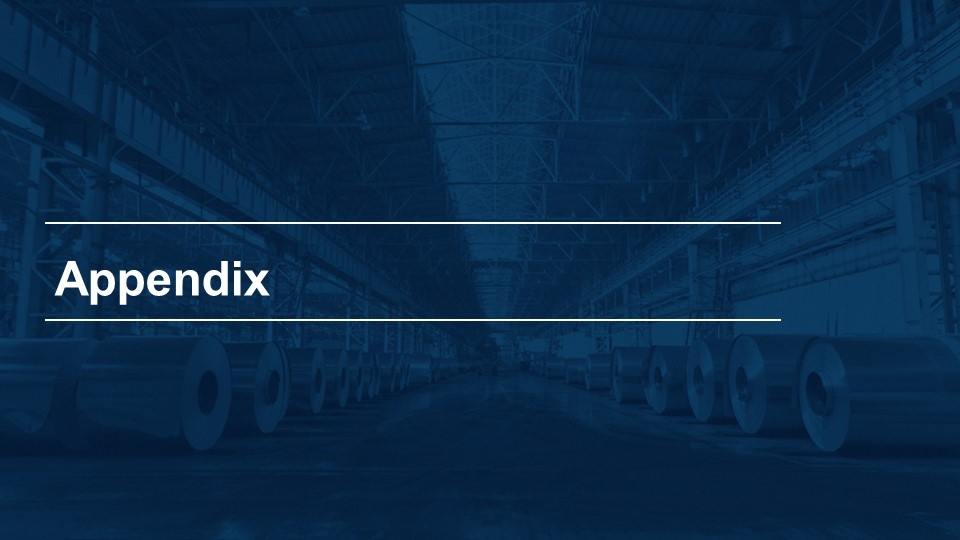
Appendix
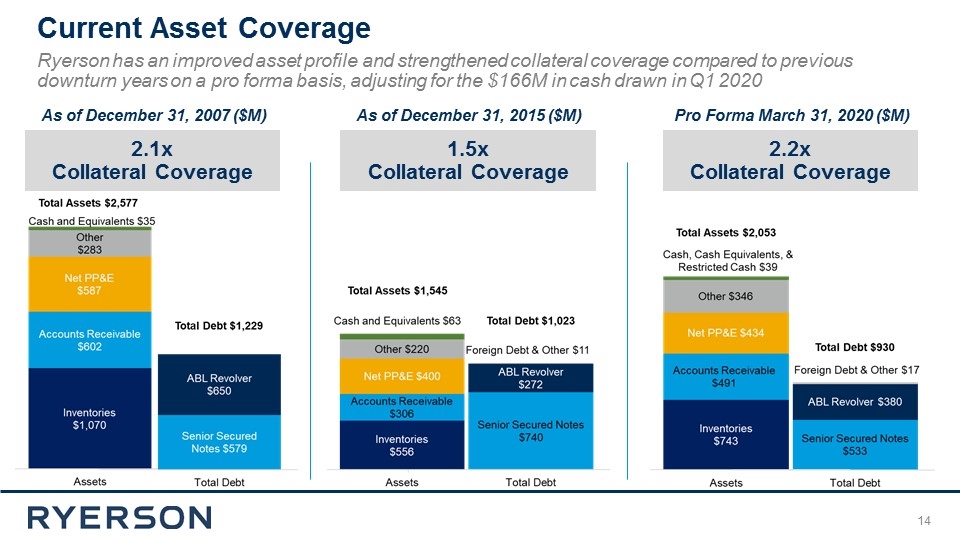
Ryerson has an improved asset profile and strengthened collateral coverage compared to previous downturn years on a pro forma basis, adjusting for the $166M in cash drawn in Q1 2020 Current Asset Coverage 2.2x Collateral Coverage Pro Forma March 31, 2020 ($M) 2.1x Collateral Coverage As of December 31, 2007 ($M) 1.5x Collateral Coverage As of December 31, 2015 ($M)
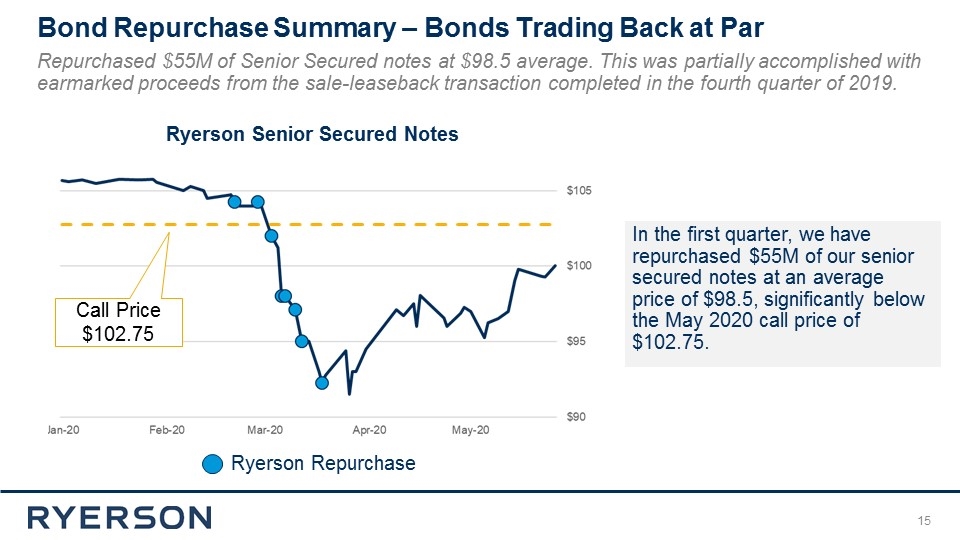
In the first quarter, we have repurchased $55M of our senior secured notes at an average price of $98.5, significantly below the May 2020 call price of $102.75. Bond Repurchase Summary – Bonds Trading Back at Par Repurchased $55M of Senior Secured notes at $98.5 average. This was partially accomplished with earmarked proceeds from the sale-leaseback transaction completed in the fourth quarter of 2019. Ryerson Senior Secured Notes Call Price $102.75 Ryerson Repurchase
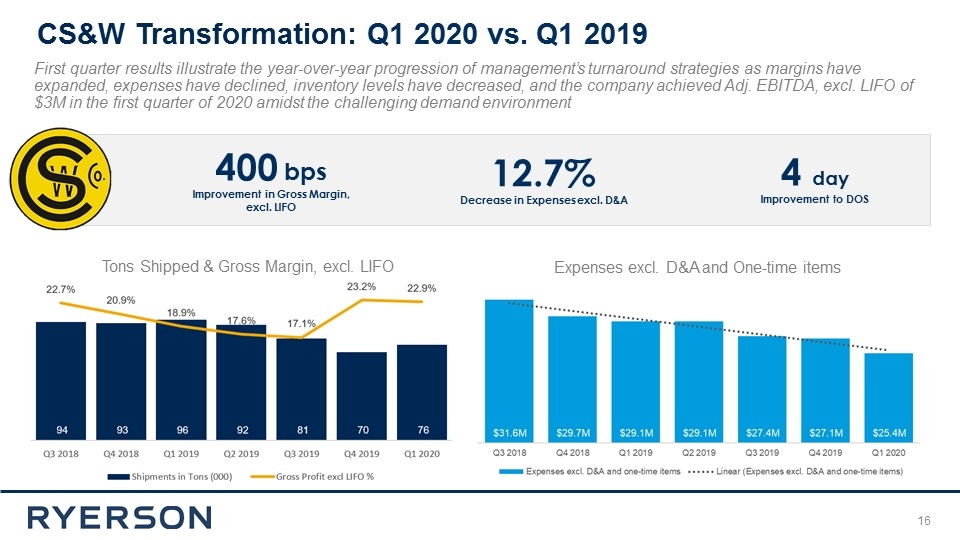
CS&W Transformation: Q1 2020 vs. Q1 2019 First quarter results illustrate the year-over-year progression of management’s turnaround strategies as margins have expanded, expenses have declined, inventory levels have decreased, and the company achieved Adj. EBITDA, excl. LIFO of $3M in the first quarter of 2020 amidst the challenging demand environment 400 bps Improvement in Gross Margin, excl. LIFO 12.7% Decrease in Expenses excl. D&A 4 day Improvement to DOS Tons Shipped & Gross Margin, excl. LIFO Expenses excl. D&A and One-time items
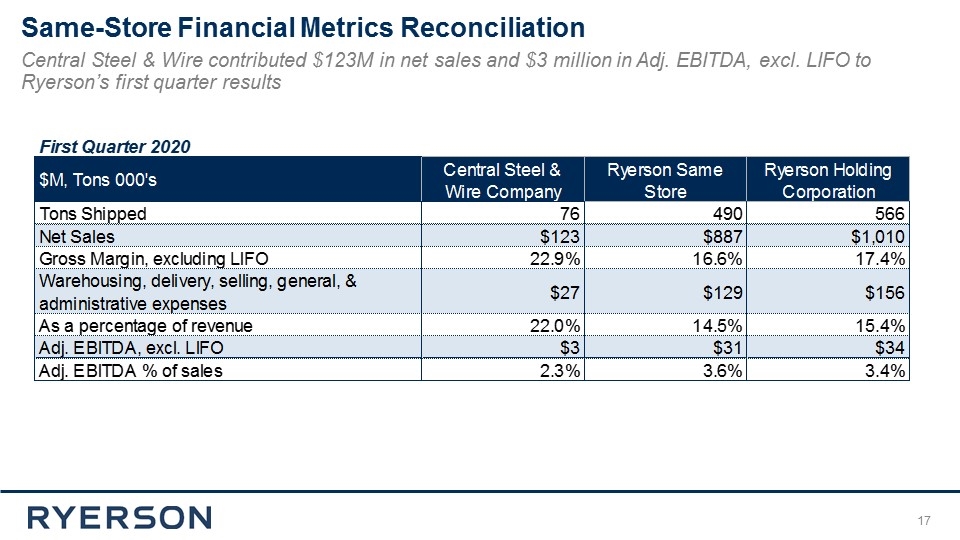
Same-Store Financial Metrics Reconciliation Central Steel & Wire contributed $123M in net sales and $3 million in Adj. EBITDA, excl. LIFO to Ryerson’s first quarter results
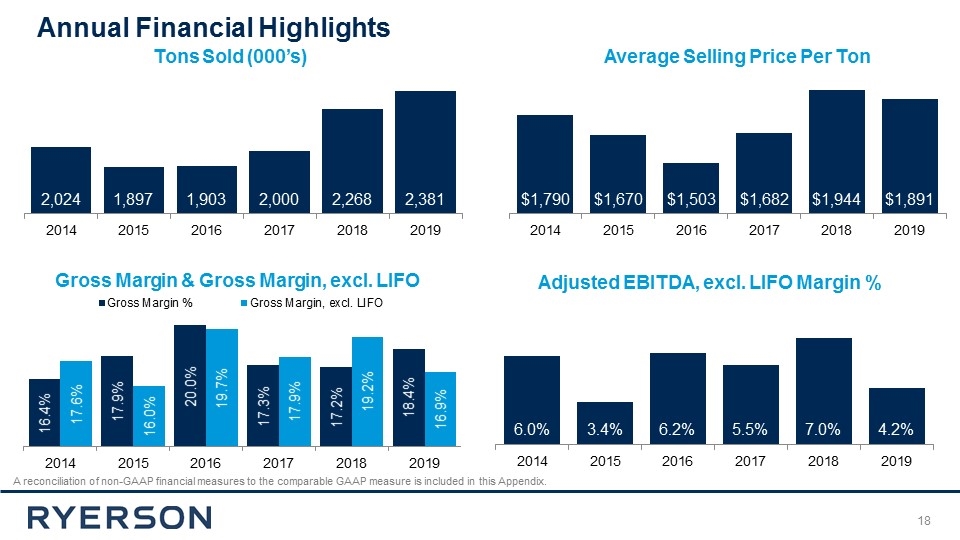
Annual Financial Highlights A reconciliation of non-GAAP financial measures to the comparable GAAP measure is included in this Appendix. Tons Sold (000’s) Average Selling Price Per Ton Gross Margin & Gross Margin, excl. LIFO Adjusted EBITDA, excl. LIFO Margin %
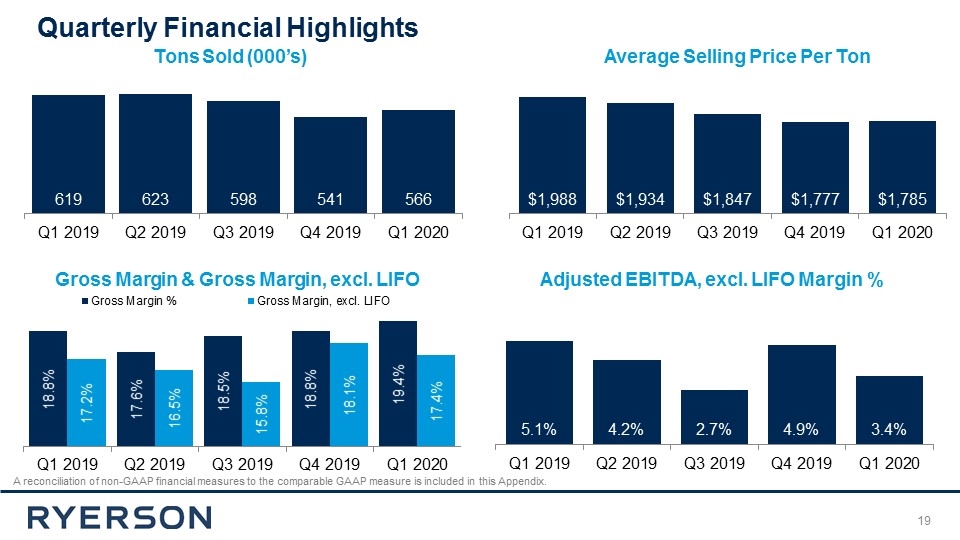
Quarterly Financial Highlights A reconciliation of non-GAAP financial measures to the comparable GAAP measure is included in this Appendix. Tons Sold (000’s) Average Selling Price Per Ton Adjusted EBITDA, excl. LIFO Margin % Gross Margin & Gross Margin, excl. LIFO
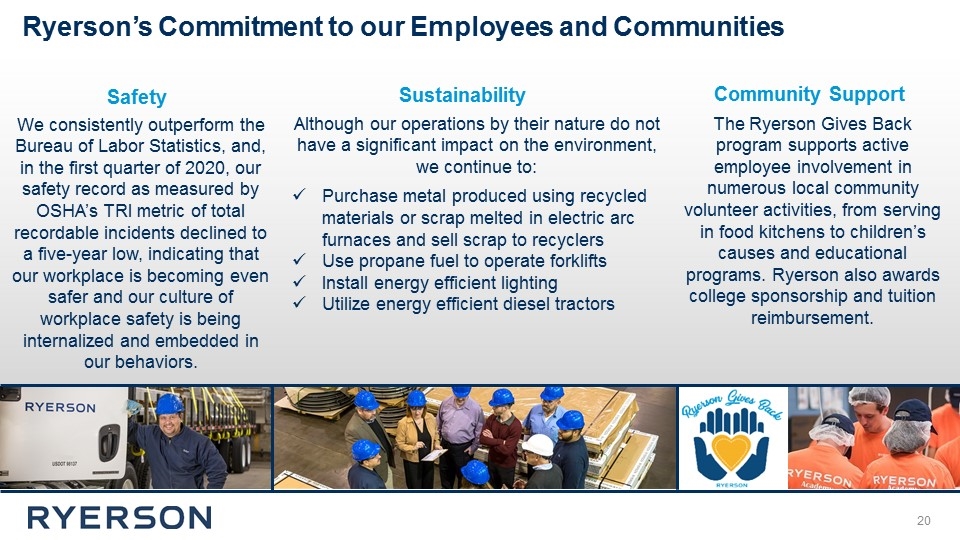
Although our operations by their nature do not have a significant impact on the environment, we continue to: Purchase metal produced using recycled materials or scrap melted in electric arc furnaces and sell scrap to recyclers Use propane fuel to operate forklifts Install energy efficient lighting Utilize energy efficient diesel tractors Ryerson’s Commitment to our Employees and Communities Safety Community Support Sustainability We consistently outperform the Bureau of Labor Statistics, and, in the first quarter of 2020, our safety record as measured by OSHA’s TRI metric of total recordable incidents declined to a five-year low, indicating that our workplace is becoming even safer and our culture of workplace safety is being internalized and embedded in our behaviors. The Ryerson Gives Back program supports active employee involvement in numerous local community volunteer activities, from serving in food kitchens to children’s causes and educational programs. Ryerson also awards college sponsorship and tuition reimbursement.
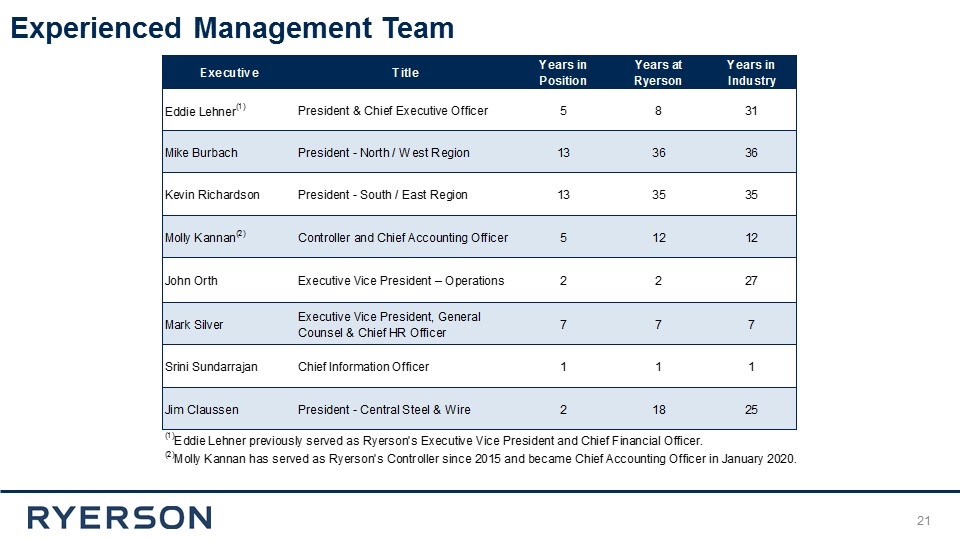
Experienced Management Team
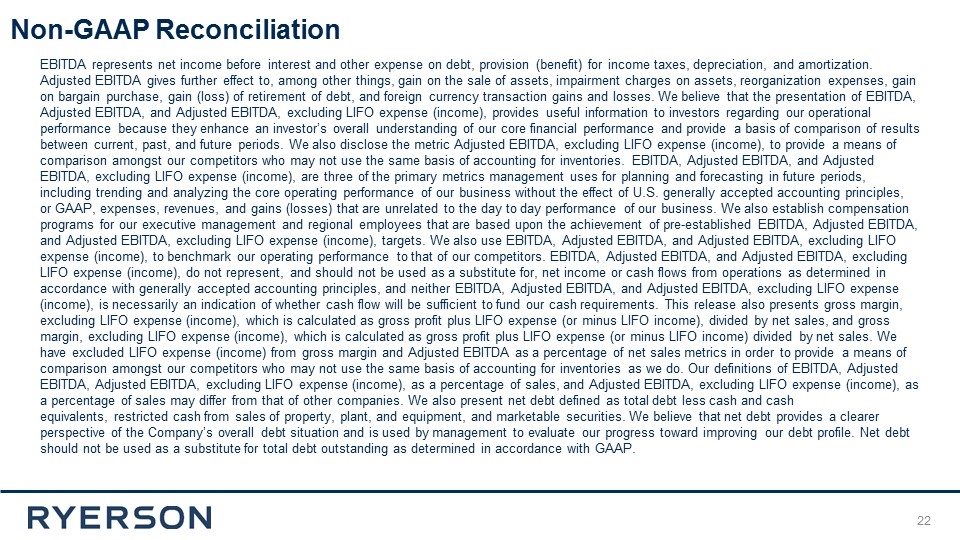
31 EBITDA represents net income before interest and other expense on debt, provision (benefit) for income taxes, depreciation, and amortization. Adjusted EBITDA gives further effect to, among other things, gain on the sale of assets, impairment charges on assets, reorganization expenses, gain on bargain purchase, gain (loss) of retirement of debt, and foreign currency transaction gains and losses. We believe that the presentation of EBITDA, Adjusted EBITDA, and Adjusted EBITDA, excluding LIFO expense (income), provides useful information to investors regarding our operational performance because they enhance an investor’s overall understanding of our core financial performance and provide a basis of comparison of results between current, past, and future periods. We also disclose the metric Adjusted EBITDA, excluding LIFO expense (income), to provide a means of comparison amongst our competitors who may not use the same basis of accounting for inventories. EBITDA, Adjusted EBITDA, and Adjusted EBITDA, excluding LIFO expense (income), are three of the primary metrics management uses for planning and forecasting in future periods, including trending and analyzing the core operating performance of our business without the effect of U.S. generally accepted accounting principles, or GAAP, expenses, revenues, and gains (losses) that are unrelated to the day to day performance of our business. We also establish compensation programs for our executive management and regional employees that are based upon the achievement of pre-established EBITDA, Adjusted EBITDA, and Adjusted EBITDA, excluding LIFO expense (income), targets. We also use EBITDA, Adjusted EBITDA, and Adjusted EBITDA, excluding LIFO expense (income), to benchmark our operating performance to that of our competitors. EBITDA, Adjusted EBITDA, and Adjusted EBITDA, excluding LIFO expense (income), do not represent, and should not be used as a substitute for, net income or cash flows from operations as determined in accordance with generally accepted accounting principles, and neither EBITDA, Adjusted EBITDA, and Adjusted EBITDA, excluding LIFO expense (income), is necessarily an indication of whether cash flow will be sufficient to fund our cash requirements. This release also presents gross margin, excluding LIFO expense (income), which is calculated as gross profit plus LIFO expense (or minus LIFO income), divided by net sales, and gross margin, excluding LIFO expense (income), which is calculated as gross profit plus LIFO expense (or minus LIFO income) divided by net sales. We have excluded LIFO expense (income) from gross margin and Adjusted EBITDA as a percentage of net sales metrics in order to provide a means of comparison amongst our competitors who may not use the same basis of accounting for inventories as we do. Our definitions of EBITDA, Adjusted EBITDA, Adjusted EBITDA, excluding LIFO expense (income), as a percentage of sales, and Adjusted EBITDA, excluding LIFO expense (income), as a percentage of sales may differ from that of other companies. We also present net debt defined as total debt less cash and cash equivalents, restricted cash from sales of property, plant, and equipment, and marketable securities. We believe that net debt provides a clearer perspective of the Company’s overall debt situation and is used by management to evaluate our progress toward improving our debt profile. Net debt should not be used as a substitute for total debt outstanding as determined in accordance with GAAP. Non-GAAP Reconciliation
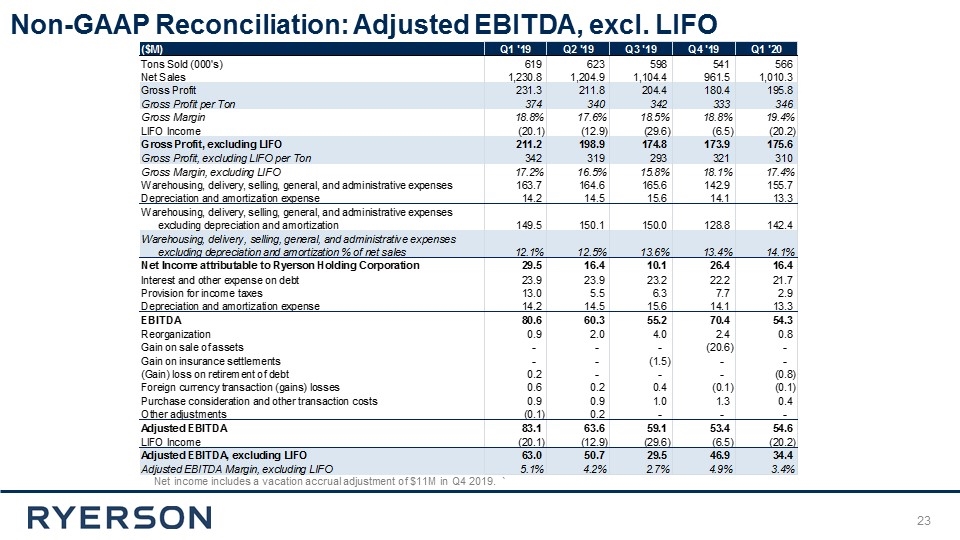
Non-GAAP Reconciliation: Adjusted EBITDA, excl. LIFO Net income includes a vacation accrual adjustment of $11M in Q4 2019. `
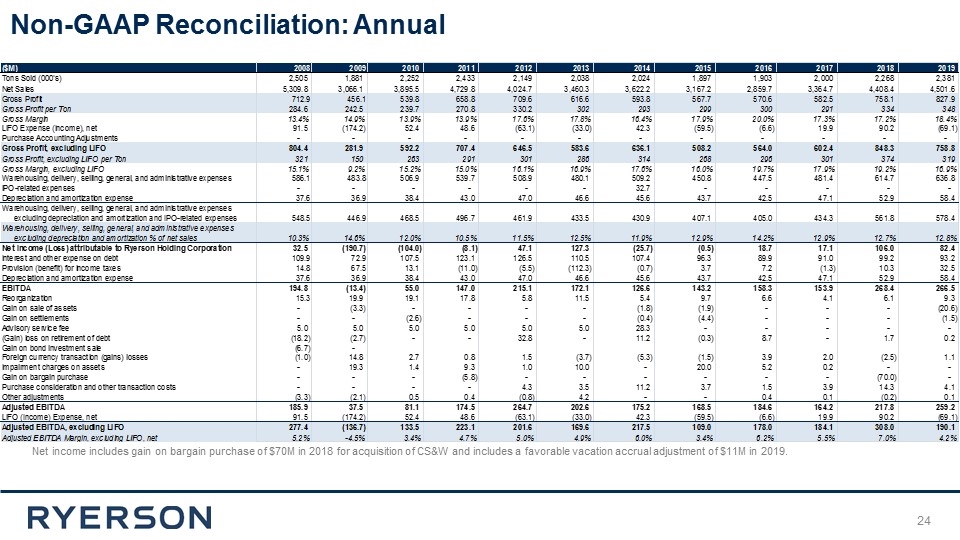
Non-GAAP Reconciliation: Annual Net income includes gain on bargain purchase of $70M in 2018 for acquisition of CS&W and includes a favorable vacation accrual adjustment of $11M in 2019.
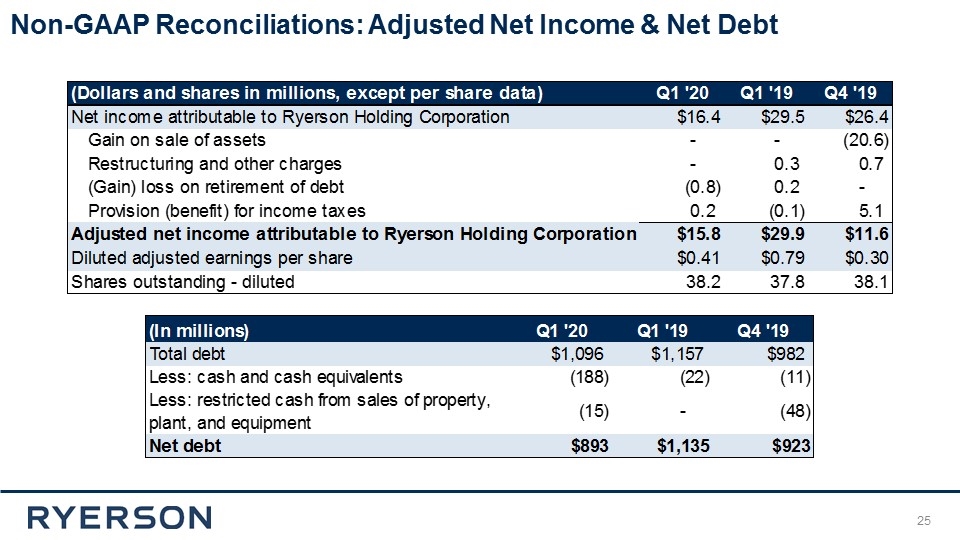
Non-GAAP Reconciliations: Adjusted Net Income & Net Debt
